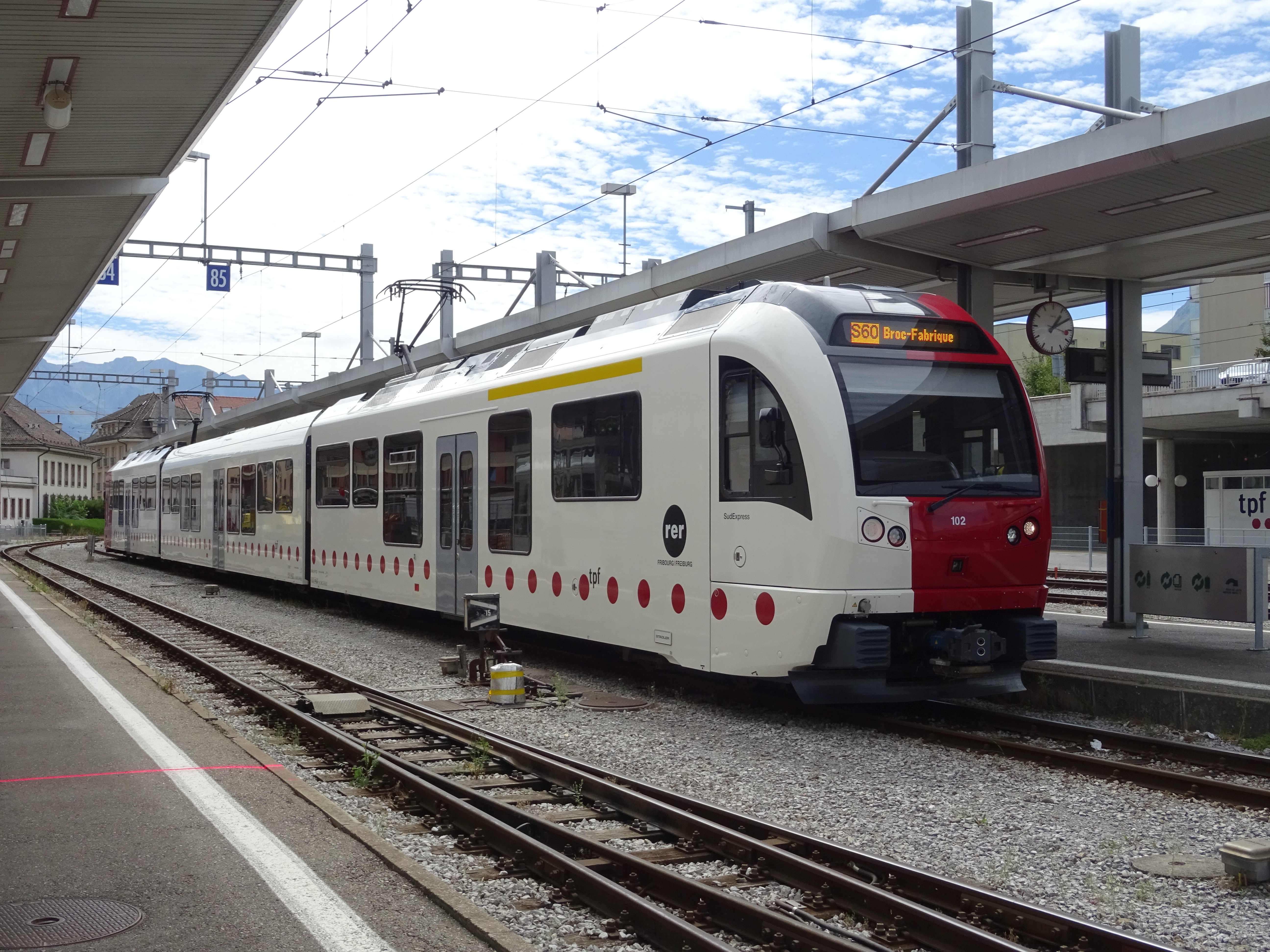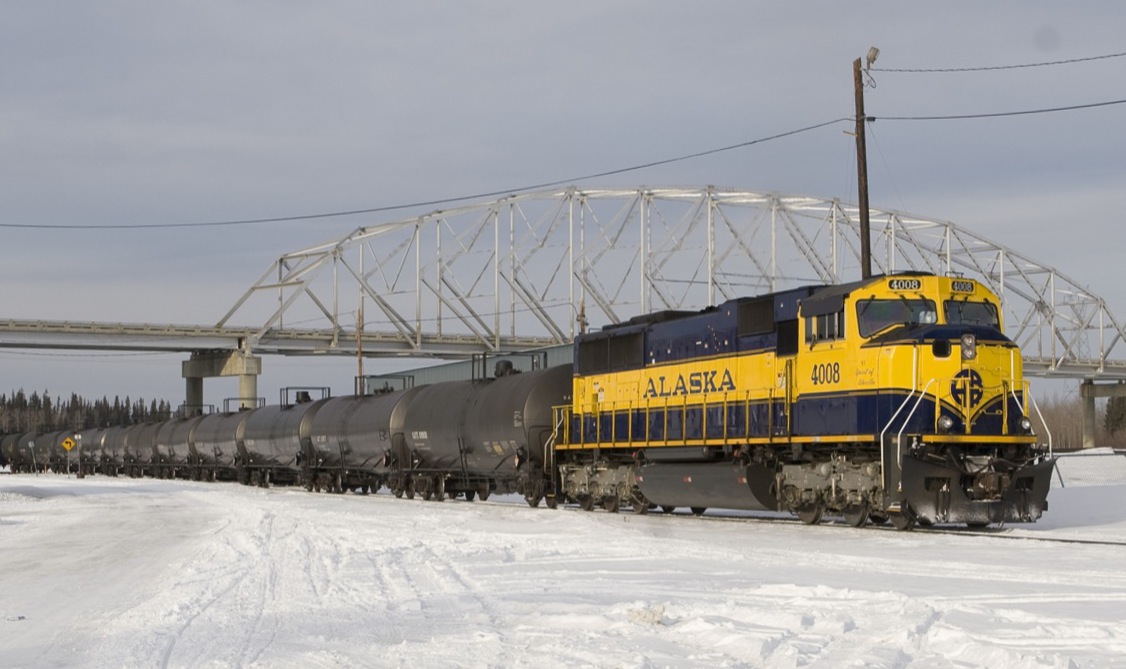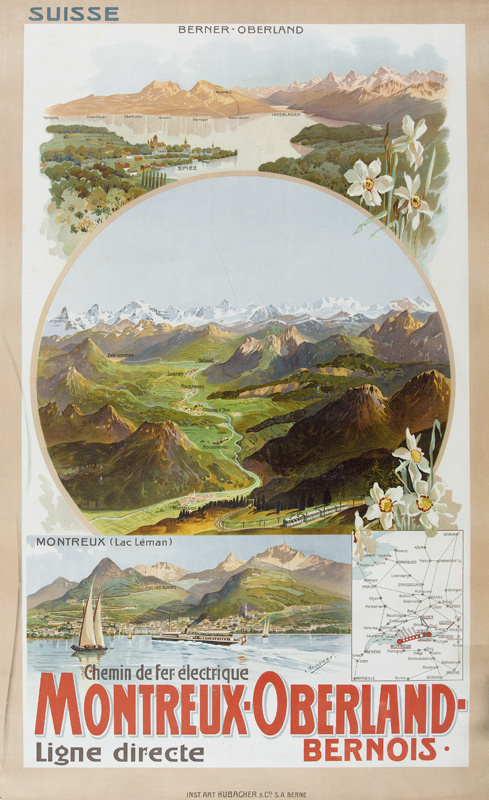|
Palézieux–Bulle–Montbovon Railway Line
The Palézieux–Bulle–Montbovon railway line is a railway line in the canton of Fribourg, Switzerland. It runs from to . The line is owned and operated by Transports publics Fribourgeois (TPF). History The first section between and opened on 29 April 1901. It was built by the Chemin de fer Châtel-St-Denis–Palézieux (CP). The Chemins de fer électriques de la Gruyère (CEG) built another line east from Châtel-St-Denis to Vuadens, opening on 23 July 1903. At the same time, the CEG opened a line north from to La Tour-de-Trême. The CEG closed the gap in 1904, completing sections between Vaudens and on 14 July and Bulle and La Tour-de-Trême on 21 September. The CEG acquired the CP on 20 December 1907. In 1942, the CEG merged with two other companies to form the Chemins de fer fribourgeois Gruyère–Fribourg–Morat (GFM). The GFM, in turn, became the Transports publics Fribourgeois (TPF) in 2000. Route The line begins in Palézieux, where it terminates across th ... [...More Info...] [...Related Items...] OR: [Wikipedia] [Google] [Baidu] |
RER Fribourg
RER Fribourg or RER Fribourg , Freiburg (, ) is an S-Bahn network in the canton of Fribourg in Switzerland. The network has two hubs, Bulle and Fribourg, and began operating in . History The RER Fribourg network began operation with the 11 December 2011 timetable change. At the outset, the network consisted of a half-hourly RegioExpress service between and , with rush-hour service between Fribourg and . On 9 December 2012, half-hourly operation was introduced between and , on the Palézieux–Bulle–Montbovon railway line. As part of the new service, eight stations on the line closed. Also introduced was hourly service on the Bulle–Broc railway line, with through operation to and from . These improvements were known collectively as "RER Sud" (south). In addition, the frequency of the RegioExpress service between Fribourg and Bern became hourly. With the December 2014 timetable change, S-Bahn-style "S" designations were applied for the first time: * S20 (RER Fribourg), S ... [...More Info...] [...Related Items...] OR: [Wikipedia] [Google] [Baidu] |
Swiss Federal Railways
Swiss Federal Railways (, SBB; , CFF; , FFS) is the national railway company of Switzerland. The company was founded in 1902 and is headquartered in Bern. It used to be a State-owned enterprise, government institution, but since 1999 it has been a special stock corporation whose shares are held by the Swiss Confederation and the Cantons of Switzerland, Swiss cantons. It is the largest rail and transport company of Switzerland; it operates on most standard gauge lines of the Rail transport in Switzerland, Swiss railway network. It also heavily collaborates with most other transport companies of the country, such as the BLS AG, BLS, one of its main competitors, or (SOB), to provide fully integrated public transport timetable, timetables with Clock-face scheduling, cyclic schedules. SBB was ranked first among national Rail transport in Europe, European rail systems in the 2017 European Railway Performance Index for its intensity of use, quality of service, and safety rating. Whil ... [...More Info...] [...Related Items...] OR: [Wikipedia] [Google] [Baidu] |
Transport In The Canton Of Vaud
Transport (in British English) or transportation (in American English) is the intentional Motion, movement of humans, animals, and cargo, goods from one location to another. Mode of transport, Modes of transport include aviation, air, land transport, land (rail transport, rail and road transport, road), ship transport, water, cable transport, cable, pipeline transport, pipelines, and space transport, space. The field can be divided into infrastructure, vehicles, and operations. Transport enables human trade, which is essential for the development of civilizations. Transport infrastructure consists of both fixed installations, including roads, railways, airway (aviation), airways, waterways, canals, and pipeline transport, pipelines, and terminals such as airports, train station, railway stations, bus stations, warehouses, trucking terminals, refueling depots (including fuel docks and fuel stations), and seaports. Terminals may be used both for the interchange of passengers and ... [...More Info...] [...Related Items...] OR: [Wikipedia] [Google] [Baidu] |
Transport In The Canton Of Fribourg
Transport (in British English) or transportation (in American English) is the intentional movement of humans, animals, and goods from one location to another. Modes of transport include air, land (rail and road), water, cable, pipelines, and space. The field can be divided into infrastructure, vehicles, and operations. Transport enables human trade, which is essential for the development of civilizations. Transport infrastructure consists of both fixed installations, including roads, railways, airways, waterways, canals, and pipelines, and terminals such as airports, railway stations, bus stations, warehouses, trucking terminals, refueling depots (including fuel docks and fuel stations), and seaports. Terminals may be used both for the interchange of passengers and cargo and for maintenance. Means of transport are any of the different kinds of transport facilities used to carry people or cargo. They may include vehicles, riding animals, and pack animals. Vehicles may includ ... [...More Info...] [...Related Items...] OR: [Wikipedia] [Google] [Baidu] |
Metre-gauge Railways In Switzerland
Metre-gauge railways ( US: meter-gauge railways) are narrow-gauge railways with track gauge of or 1 metre. Metre gauge is used in around of tracks around the world. It was used by several European colonial powers including France, Britain and Germany in their colonies. In Europe, large metre-gauge networks remain in use in Switzerland, Spain and many European towns with urban trams, but most metre-gauge local railways in France, Germany and Belgium closed down in the mid-20th century, although some still remain. With the revival of urban rail transport, metre-gauge light metros were built in some cities. The slightly-wider gauge is used in Sofia, Bulgaria. Another similar gauge is . __TOC__ Examples of metre-gauge See also * Italian metre gauge * Narrow-gauge railways A narrow-gauge railway (narrow-gauge railroad in the US) is a railway with a track gauge (distance between the rails) narrower than . Most narrow-gauge railways are between and . Since narrow-gaug ... [...More Info...] [...Related Items...] OR: [Wikipedia] [Google] [Baidu] |
Railway Lines In Switzerland
Rail transport (also known as train transport) is a means of transport using wheeled vehicles running in tracks, which usually consist of two parallel steel rails. Rail transport is one of the two primary means of land transport, next to road transport. It is used for about 8% of passenger and freight transport globally, thanks to its energy efficiency and potentially high speed.Rolling stock on rails generally encounters lower frictional resistance than rubber-tyred road vehicles, allowing rail cars to be coupled into longer trains. Power is usually provided by diesel or electric locomotives. While railway transport is capital-intensive and less flexible than road transport, it can carry heavy loads of passengers and cargo with greater energy efficiency and safety. Precursors of railways driven by human or animal power have existed since antiquity, but modern rail transport began with the invention of the steam locomotive in the United Kingdom at the beginning of the 19 ... [...More Info...] [...Related Items...] OR: [Wikipedia] [Google] [Baidu] |
Montreux Oberland Bernois Railway
The Montreux Oberland Bernois Railway (, , abbreviated MOB) is a company that operates an electrified railway line, the Montreux–Lenk im Simmental line, in southwest Switzerland, one of the oldest electric railways in the country. Its main line, in length, is built to the gauge. It connects Montreux railway station, Montreux, Gstaad, and Zweisimmen. At Zweisimmen, passengers may transfer to the Spiez–Erlenbach–Zweisimmen railway line, Zweisimmen to Spiez line — a standard gauge line owned by BLS AG. A branch-line also connects Zweisimmen to Lenk im Simmental, Lenk. History and route The main line of the MOB was opened in stages, the first, from Montreux railway station, Montreux to Les Avants () on 17 December 1901, followed by the Les Avants to Montbovon () section on 1 October 1903. The next stages from Montbovon to Château-d'Œx () and then Gstaad () followed on 19 August 1904 and 20 December 1904 respectively, the final of the line reaching Zweisimmen on 6 Jul ... [...More Info...] [...Related Items...] OR: [Wikipedia] [Google] [Baidu] |
Montreux–Lenk Im Simmental Line
The Montreux–Lenk im Simmental line is a metre-gauge electric railway line in Switzerland run by the Montreux Oberland Bernois Railway (MOB) and links Montreux on Lake Geneva by way of Les Avants, Montbovon, Rossinière, Château-d'Œx, Rougemont, Saanen, Gstaad and Zweisimmen with Lenk im Simmental. It leads through the cantons of Vaud, Fribourg and Bern. Running along the section between Montreux and Zweisimmen is the GoldenPass Line. The Montreux–Lenk line is one of the oldest electric railways in the country. Its main line, in length, is built to the gauge. At Zweisimmen, passengers may transfer to the Spiez–Erlenbach–Zweisimmen line, a standard gauge line owned by BLS AG. A branch line also connects Zweisimmen to Lenk. History The first section of line opened on 18 December 1901, between and . The line was further extended from Les Avants to on 1 October 1903, Chateau d'Œx on 19 August 1904, Gstaad on 20 December 1904, and on 6 July 1905. The exten ... [...More Info...] [...Related Items...] OR: [Wikipedia] [Google] [Baidu] |
Bulle–Broc Railway Line
The Bulle–Broc railway line is a railway line in the canton of Fribourg, Switzerland. It runs from to . It was built in 1912 by the Chemins de fer électriques de la Gruyère (CEG) as a branch from the Palézieux–Bulle–Montbovon railway line. Both lines were . Transports publics Fribourgeois (TPF) closed the line from 2021–2023 for rebuilding as a standard gauge line. History The Chemins de fer électriques de la Gruyère constructed the branch line in 1912, with the section from Bulle to Les Marches opening on 29 January and from Les Marches to Broc on 24 June. In 1942, the CEG merged with two other companies to form the Chemins de fer fribourgeois Gruyère–Fribourg–Morat (GFM). The GFM, in turn, became the Transports publics Fribourgeois (TPF) in 2000. Two stations were renamed with the 2017 timetable change: La Tour-Village became La Tour-de-Trême while Epagny became La Tour-de-Trême Parqueterie. The station formerly known as La Tour-de-Trême on the Pal� ... [...More Info...] [...Related Items...] OR: [Wikipedia] [Google] [Baidu] |
Bulle–Romont Railway Line
The Bulle–Romont railway line is a standard gauge railway line in the canton of Fribourg, Switzerland. It runs from to . The line is owned and operated by Transports publics Fribourgeois (TPF). History The Chemin de fer Bulle–Romont (BR) opened the line between Bulle and Romont on 1 July 1868. The line was electrified on 8 May 1946. In 1942, the BR merged with two other companies to form the Chemins de fer fribourgeois Gruyère–Fribourg–Morat (GFM). The GFM, in turn, became the Transports publics Fribourgeois The Transports Publics Fribourgeois (TPF) is a renaming of the former Chemins de fer Fribourgeois Gruyère-Fribourg-Morat when the municipal Transport en commun de Fribourg (TF) was absorbed in 2000. Lines The company is a railway operator ... (TPF) in 2000. Notes References * Railway lines in Switzerland Transport in the canton of Fribourg Railway lines opened in 1868 15 kV AC railway electrification {{DEFAULTSORT:Bulle-Romont railway ... [...More Info...] [...Related Items...] OR: [Wikipedia] [Google] [Baidu] |
Swiss Prealps
The Alpine region of Switzerland, conventionally referred to as the Swiss Alps, represents a major natural feature of the country and is, along with the Swiss Plateau and the Swiss portion of the Jura Mountains, one of its three main physiographic regions. The Swiss Alps extend over both the Western Alps and the Eastern Alps, encompassing an area sometimes called Central Alps. While the northern ranges from the Bernese Alps to the Appenzell Alps are entirely in Switzerland, the southern ranges from the Mont Blanc massif to the Bernina massif are shared with other countries such as France, Italy, Austria and Liechtenstein. The Swiss Alps comprise almost all the highest mountains of the Alps, such as Dufourspitze (4,634 m), the Dom (4,545 m), the Liskamm (4,527 m), the Weisshorn (4,506 m) and the Matterhorn (4,478 m). The other following major summits can be found in this list of mountains of Switzerland. Since the Middle Ages, transit across the Alps played an important role ... [...More Info...] [...Related Items...] OR: [Wikipedia] [Google] [Baidu] |
St-Légier–Châtel-St-Denis Railway Line
The St-Légier–Châtel-St-Denis railway line was a railway line in the cantons of Vaud and Fribourg, Switzerland. It ran from a junction with the Vevey–Les Pléiades railway line at to a junction with the Palézieux–Bulle–Montbovon railway line The Palézieux–Bulle–Montbovon railway line is a railway line in the canton of Fribourg, Switzerland. It runs from to . The line is owned and operated by Transports publics Fribourgeois (TPF). History The first section between and ope ... at . The line was owned and operated by the Chemins de fer électriques Veveysans (CEV). It opened in 1904 and was closed in 1969. History The Chemins de fer électriques Veveysans (CEV) had opened its original line from to in 1902. The line to branched off this original line at and opened on 2 April 1904. In Châtel-St-Denis the line joined with that of the Chemin de fer Châtel-St-Denis–Palézieux (CP). The CEV closed this branch line on 31 May 1969. In 2019, the line ... [...More Info...] [...Related Items...] OR: [Wikipedia] [Google] [Baidu] |





